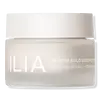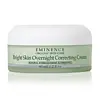What's inside
What's inside
 Key Ingredients
Key Ingredients

 Benefits
Benefits

 Concerns
Concerns

 Ingredients Side-by-side
Ingredients Side-by-side

Colloidal Oatmeal 1%
AbsorbentWater
Skin ConditioningCaprylic/Capric Triglyceride
MaskingSqualane
EmollientGlycerin
HumectantArachidyl Alcohol
EmollientPropanediol
SolventButyrospermum Parkii Butter
Skin ConditioningBehenyl Alcohol
EmollientAvena Sativa Kernel Extract
AbrasiveLithothamnion Calcareum Extract
Skin ConditioningOphiopogon Japonicus Root Extract
Skin ConditioningLactic Acid
BufferingPolyglycerin-6
HumectantPolyglyceryl-6 Laurate
EmulsifyingSodium Acrylate/Sodium Acryloyldimethyl Taurate Copolymer
Emulsion StabilisingArachidyl Glucoside
EmulsifyingC15-19 Alkane
SolventMaltodextrin
AbsorbentAmylopectin
Hydrogenated Lecithin
EmulsifyingBiosaccharide Gum-1
HumectantPentylene Glycol
Skin ConditioningTrisodium Ethylenediamine Disuccinate
Sodium Levulinate
Skin ConditioningCalcium Chloride
AstringentGlyceryl Caprylate
EmollientXanthan Gum
EmulsifyingP-Anisic Acid
Masking1,2-Hexanediol
Skin ConditioningCaprylyl Glycol
EmollientGlucose
HumectantSorbitan Oleate
EmulsifyingSorbitan Isostearate
EmulsifyingPotassium Sorbate
PreservativeSodium Benzoate
MaskingCitric Acid
BufferingColloidal Oatmeal 1%, Water, Caprylic/Capric Triglyceride, Squalane, Glycerin, Arachidyl Alcohol, Propanediol, Butyrospermum Parkii Butter, Behenyl Alcohol, Avena Sativa Kernel Extract, Lithothamnion Calcareum Extract, Ophiopogon Japonicus Root Extract, Lactic Acid, Polyglycerin-6, Polyglyceryl-6 Laurate, Sodium Acrylate/Sodium Acryloyldimethyl Taurate Copolymer, Arachidyl Glucoside, C15-19 Alkane, Maltodextrin, Amylopectin, Hydrogenated Lecithin, Biosaccharide Gum-1, Pentylene Glycol, Trisodium Ethylenediamine Disuccinate, Sodium Levulinate, Calcium Chloride, Glyceryl Caprylate, Xanthan Gum, P-Anisic Acid, 1,2-Hexanediol, Caprylyl Glycol, Glucose, Sorbitan Oleate, Sorbitan Isostearate, Potassium Sorbate, Sodium Benzoate, Citric Acid
Aloe Barbadensis Leaf Juice
Skin ConditioningGlycyrrhiza Glabra Root Extract
BleachingCitrus Limon Peel Extract
EmollientCymbopogon Schoenanthus Extract
Skin ConditioningSalix Alba Bark Extract
AstringentArctostaphylos Uva-Ursi Leaf Extract
Skin ConditioningMentha Piperita Leaf Extract
Skin ConditioningRosmarinus Officinalis Leaf Extract
AntimicrobialSalvia Officinalis Extract
AntimicrobialRicinus Communis Seed Oil
MaskingCopernicia Cerifera Wax
Cetearyl Alcohol
EmollientSodium Cetearyl Sulfate
CleansingButyrospermum Parkii Butter
Skin ConditioningSimmondsia Chinensis Seed Oil
EmollientBoerhavia Diffusa Root Extract
Skin ProtectingMalva Sylvestris Extract
AstringentPrimula Veris Extract
Skin ConditioningAlchemilla Vulgaris Extract
AstringentVeronica Officinalis Extract
Skin ConditioningMelissa Officinalis Leaf Extract
Skin ConditioningAchillea Millefolium Extract
CleansingGlycerin
HumectantCaesalpinia Spinosa Gum
Skin ConditioningSodium Benzoate
MaskingPotassium Sorbate
PreservativeStearic Acid
CleansingSempervivum Tectorum Extract
Skin ConditioningCurcuma Longa Root Extract
MaskingBenzyl Alcohol
PerfumingDehydroacetic Acid
PreservativeTocopheryl Acetate
AntioxidantHypoxis Rooperi Rhizome Extract
Skin ConditioningMethyl Glucose Sesquistearate
EmollientXanthan Gum
EmulsifyingSqualane
EmollientUbiquinone
AntioxidantCitrus Aurantifolia Peel Extract
CleansingSalicylic Acid
MaskingLactic Acid
BufferingCitrus Limon Peel Oil
MaskingCI 75810
Cosmetic ColorantAscorbyl Palmitate
AntioxidantLecithin
EmollientEuterpe Oleracea Sterols
Skin ConditioningCitrus Limon Peel
MaskingMalpighia Glabra Fruit
Skin ConditioningEmblica Officinalis Fruit
Skin ConditioningAdansonia Digitata Oil
EmollientMyrciaria Cauliflora Pulp
Skin ConditioningDaucus Carota Sativa Callus Lysate
AntioxidantCocos Nucifera Water
MaskingLycium Barbarum Amino Acids
Skin ConditioningTapioca Starch
Aloe Barbadensis Leaf Juice, Glycyrrhiza Glabra Root Extract, Citrus Limon Peel Extract, Cymbopogon Schoenanthus Extract, Salix Alba Bark Extract, Arctostaphylos Uva-Ursi Leaf Extract, Mentha Piperita Leaf Extract, Rosmarinus Officinalis Leaf Extract, Salvia Officinalis Extract, Ricinus Communis Seed Oil, Copernicia Cerifera Wax, Cetearyl Alcohol, Sodium Cetearyl Sulfate, Butyrospermum Parkii Butter, Simmondsia Chinensis Seed Oil, Boerhavia Diffusa Root Extract, Malva Sylvestris Extract, Primula Veris Extract, Alchemilla Vulgaris Extract, Veronica Officinalis Extract, Melissa Officinalis Leaf Extract, Achillea Millefolium Extract, Glycerin, Caesalpinia Spinosa Gum, Sodium Benzoate, Potassium Sorbate, Stearic Acid, Sempervivum Tectorum Extract, Curcuma Longa Root Extract, Benzyl Alcohol, Dehydroacetic Acid, Tocopheryl Acetate, Hypoxis Rooperi Rhizome Extract, Methyl Glucose Sesquistearate, Xanthan Gum, Squalane, Ubiquinone, Citrus Aurantifolia Peel Extract, Salicylic Acid, Lactic Acid, Citrus Limon Peel Oil, CI 75810, Ascorbyl Palmitate, Lecithin, Euterpe Oleracea Sterols, Citrus Limon Peel, Malpighia Glabra Fruit, Emblica Officinalis Fruit, Adansonia Digitata Oil, Myrciaria Cauliflora Pulp, Daucus Carota Sativa Callus Lysate, Cocos Nucifera Water, Lycium Barbarum Amino Acids, Tapioca Starch
Alternatives
Ingredients Explained
These ingredients are found in both products.
Ingredients higher up in an ingredient list are typically present in a larger amount.
This ingredient is also known as shea butter. It is an effective skin hydrator and emollient.
Emollients help soothe and soften your skin. It does this by creating a protective film on your skin. This barrier helps trap moisture and keeps your skin hydrated. Emollients may be effective at treating dry or itchy skin.
Shea butter is rich in antioxidants. Antioxidants help fight free-radicals, or molecules that may harm the body. It is also full of fatty acids including stearic acid and linoleic acid. These acids help replenish the skin and keep skin moisturized.
While Shea Butter has an SPF rating of about 3-4, it is not a sunscreen replacement.
Shea butter may not be fungal acne safe. We recommend speaking with a professional if you have any concerns.
Learn more about Butyrospermum Parkii ButterGlycerin is already naturally found in your skin. It helps moisturize and protect your skin.
A study from 2016 found glycerin to be more effective as a humectant than AHAs and hyaluronic acid.
As a humectant, it helps the skin stay hydrated by pulling moisture to your skin. The low molecular weight of glycerin allows it to pull moisture into the deeper layers of your skin.
Hydrated skin improves your skin barrier; Your skin barrier helps protect against irritants and bacteria.
Glycerin has also been found to have antimicrobial and antiviral properties. Due to these properties, glycerin is often used in wound and burn treatments.
In cosmetics, glycerin is usually derived from plants such as soybean or palm. However, it can also be sourced from animals, such as tallow or animal fat.
This ingredient is organic, colorless, odorless, and non-toxic.
Glycerin is the name for this ingredient in American English. British English uses Glycerol/Glycerine.
Learn more about GlycerinLactic Acid is another well-loved alpha hydroxy acid (AHA). It is gentler than glycolic acid but still highly effective.
Its main role is to exfoliate the surface of the skin by loosening the “glue” that holds dead skin cells together. Shedding those old cells leads to smoother, softer, and more even-toned skin.
Because lactic acid molecules are larger than glycolic acid, they don’t penetrate as deeply. This means they’re less likely to sting or irritate, making it a great choice for beginners or those with sensitive skin.
Like glycolic acid, it can:
Lactic acid also acts as a humectant (like hyaluronic acid). It can draw water into the skin to improve hydration and also plays a role in the skin's natural moisturizing factor (NMF) in the form of sodium lactate.
Studies show it can boost ceramide production to strengthen the skin barrier and even help balance the skin’s microbiome.
To get results, choose products with a pH between 3-4.
Lower strengths (5-12%) focus on surface exfoliation; higher strengths (12% and up) can reach deeper in the dermis (deeper, supportive layer) to improve skin texture and firmness over time.
Though it was originally derived from milk, most modern lactic acid used in skincare is vegan. It is made through non-dairy fermentation to create a bio-identical and stable form suitable for all formulations.
When lactic acid shows up near the end of an ingredient list, it usually means the brand added just a tiny amount to adjust the product’s pH.
Legend has it that Cleopatra used to bathe in sour milk to help reduce wrinkles.
Lactic acid is truly a gentle multitasker: it exfoliates, hydrates, strengthens, and brightens. It's a great ingredient for giving your skin a smooth, glowing, and healthy look without the harshness of stronger acids.
Read more about some other popular AHA's here:
Learn more about Lactic AcidPotassium Sorbate is a preservative used to prevent yeast and mold in products. It is commonly found in both cosmetic and food products.
This ingredient comes from potassium salt derived from sorbic acid. Sorbic acid is a natural antibiotic and effective against fungus.
Both potassium sorbate and sorbic acid can be found in baked goods, cheeses, dried meats, dried fruit, ice cream, pickles, wine, yogurt, and more.
You'll often find this ingredient used with other preservatives.
Learn more about Potassium SorbateSodium Benzoate is a preservative. It's used in both cosmetic and food products to inhibit the growth of mold and bacteria. It is typically produced synthetically.
Both the US FDA and EU Health Committee have approved the use of sodium benzoate. In the US, levels of 0.1% (of the total product) are allowed.
Sodium benzoate works as a preservative by inhibiting the growth of bacteria inside of cells. It prevents the cell from fermenting a type of sugar using an enzyme called phosphofructokinase.
It is the salt of benzoic acid. Foods containing sodium benzoate include soda, salad dressings, condiments, fruit juices, wines, and snack foods.
Studies for using ascorbic acid and sodium benzoate in cosmetics are lacking, especially in skincare routines with multiple steps.
We always recommend speaking with a professional, such as a dermatologist, if you have any concerns.
Learn more about Sodium BenzoateSqualane is an emollient that helps the skin hold onto moisture. It's an oily liquid that occurs naturally in certain types of fish and plant oils.
Because squalane boosts hydration in the skin, it also comes with plenty of benefits: it is an antioxidant and can help fight free radicals and skin damage. Squalane is also found to have a detoxifying effect when applied.
Squalane comes from squalene, which occurs naturally within the sebum of our skin. It is one of the oils our skin produces to keep itself hydrated. Squalane is the hydrogenated version of squalene and has a longer shelf life.
Research shows that squalane is non-irritating (even at 100% concentration).
In general, it's a fantastic ingredient. It does a great job at hydrating the skin, and it's suitable for those with sensitive skin.
The source of squalane may impact malassezia / fungal acne. This is because olive oil derived squalane can contain impurities such as fatty acids and plant waxes. Sugarcane derived squalane is recommended for anyone with malassezia concerns.
Is squalane vegan?
This depends on the source. Squalane can be derived from both plants and animals. Most squalane used in skincare comes from plants.
Please note: the source of squalane is only known if disclosed by the brand. We recommend reaching out to the brand if you have any questions about their squalane.
Read more about squalene with an "e".
Is squalane an oil?
Squalane is often called an oil, but it’s technically not; it’s a hydrocarbon, meaning it’s only made of carbon and hydrogen, unlike true oils which are triglycerides made of fatty acids and glycerol.
The term “oil-free” isn’t regulated, so companies can define it however they want. Some exclude all oils, while others just avoid mineral oil or comedogenic oils.
While some people avoid oils thinking they cause breakouts, the right kind of oil (or oil-like ingredient like squalane) can actually help balance and hydrate your skin. It’s worth testing out simple oils or squalane to see what works best for your skin.
Learn more about SqualaneXanthan gum is used as a stabilizer and thickener within cosmetic products. It helps give products a sticky, thick feeling - preventing them from being too runny.
On the technical side of things, xanthan gum is a polysaccharide - a combination consisting of multiple sugar molecules bonded together.
Xanthan gum is a pretty common and great ingredient. It is a natural, non-toxic, non-irritating ingredient that is also commonly used in food products.
Learn more about Xanthan Gum